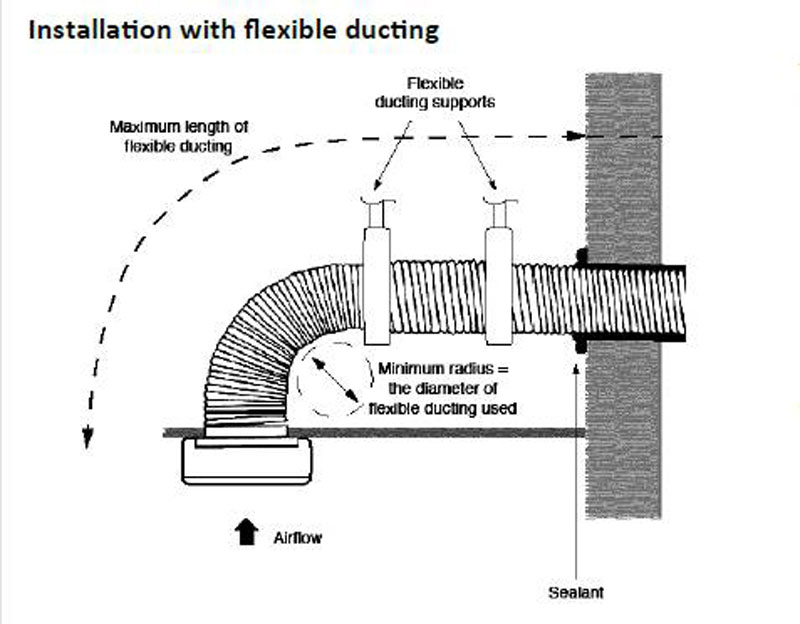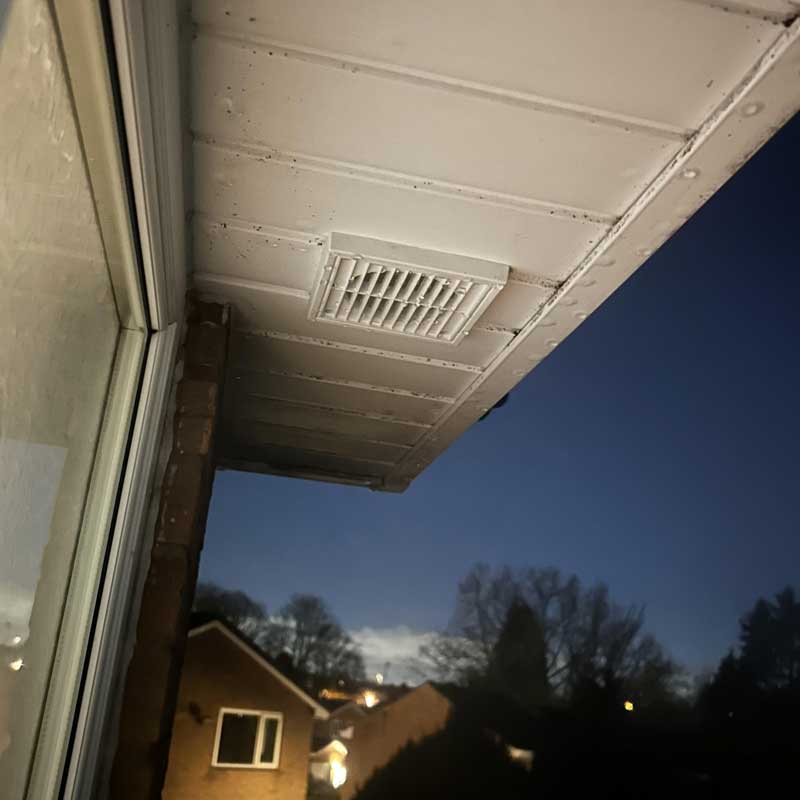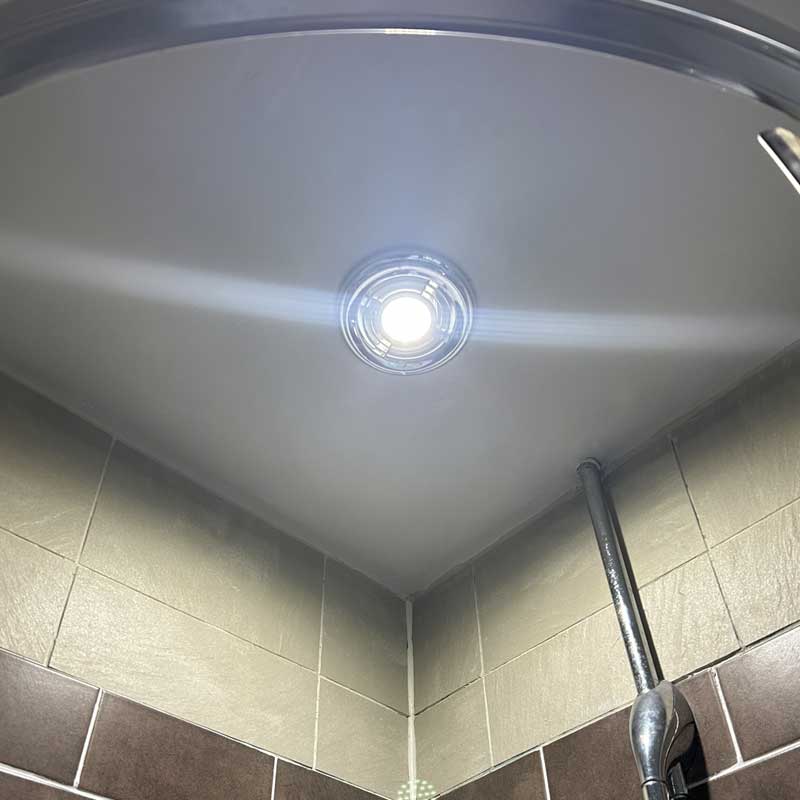Bathroom Upgrade: Enhancing Extraction Rate & New Downlights
When Chris started to notice increased levels of condensation in his bathroom, he knew his bathroom's ventilation wasn't up to par and thought it was time for an upgrade. The existing setup, particularly the inefficient extractor fan and outdated LED downlights, needed a modern touch.

Challenge
Chris's main concerns revolved around the ineffective extractor fan installed above his shower, which struggled with moisture control. Chris commented "This system had become so inefficient that it wasn't even extracting a single particle of water or dust from the air". Additionally, the flexible ducting system was not performing optimally, it had become crushed under the thermal insulation and lost its shape. Flexible ducting must be pulled to 90% of its tightness according to industry best practice guides.
The existing LED downlights in his bathroom also fell short in terms of lighting quality and the brushed steel finish had began to deteriorate.
Solution
To address these issues, we proposed a comprehensive upgrade plan:
Extractor Fan Upgrade
We replaced the old fan with a new, more powerful model that includes an integrated LED downlight, enhancing both ventilation and lighting over the shower area. Selecting a higher performance shower fan kit from the Airflow brand. We also went a step further by upgrading the in-line Aventa fan than comes with the kit to an Aura Turbo fan.
The original and inefficient shower fan had an airflow rate of just 24 litres per second, so replacing this with a like for like model would be a waste of time and money. After consulting with the Airflow technical team we chose the 9041408 model Aventa shower fan LED downlight kit (shown below), which had an airflow rate of up to 52 litres per second.
This bathroom was quite large at 11.4m3, we decided to upgrade the inline fan to the next model which was the 90001673 Aura In-Line Turbo Mixed Flow (shown below) which has an airflow rate of up to 55 litres per second.
We were also upgrading the ventilation and downlights in another room at the same time. This room was a smaller en-suite at 6.2m3, we thought it would be interesting to compare extraction results from the standard Aventa version to the Aura Turbo fan.

Ducting System Enhancement
The existing flexible ducting had two lots of ducting connected together with a tee section. We replaced the flexible ducting for rigid ducting and separated each run, significantly improving air flow and efficiency.
Where flexible ducting is used, the diameter must be maintained with the minimum radius of a bend equal to the diameter of the ducting. It is good ventilation practice that the ducting is extended to 90% of its possible length in order to maintain the best possible airflow. Ensure that flexible duct connections are not over-tightened to the fan outlet spigot.
To maximise airflow, rigid ducting should be used where possible. The fan and ducting should be installed with accordance with the requirements of the Domestic Ventilation Compliance Guide, document F of the Building Regulations.

The ducting became more of a hybrid system as we still used some of the flexible ducting for the bends. While the 100mm rigid ducting was used for the longer straight runs that led in and out of the inline fans. More flexible ducting was then used to connect the external grille units.

External Grilles
The existing system didn't have the best provisions for exhaling the steam, the flexible ducting was positioned onto the eaves of the roof which wasn't ventilating properly. Fitting some new external grilles meant that the job was done properly. The grilles that come with the kits are gravity grilles with flaps, these had to be replaced with fixed ones as the the flaps weren't suitable for ceiling mounting.

LED Downlights Upgrade
We upgraded the five existing recessed downlights to the Integral EvoFire Low Glare GU10 downlights. The design of this downlight has the LED positioned further back within the downlight structure which helps to reduce eye discomfort. They're also IP65 rated for bathroom use and the 70mm hole cut out size perfectly matched the existing downlights.
As they're GU10 downlights, they don't come with an LED, we recommended the Philips 4.9W GU10 with DimTone dimming, this LED dims in colour temperature as well as brightness, producing a candlelight 2200K glow at its lower levels of brightness which is ideal for bathing, creating a superior, relaxing lighting effect.


Technical Specifications
While researching the performance of fans, its important to compare different models with their litres per second (shown as l/s) airflow rate. This information is usually available on a data sheet or product listing. Interestingly an entry level extractor fan has an airflow rate of around 23 litres per second which wouldn't be up to the job of ventilating a bathroom that has a bath or shower, these basic fans are better suited for toilets. The high performance in-line centrifugal fans are far better.
Air Changes Per Hour
Another important criteria to consider when specifying the correct extractor fan is for your room size. Air changes per hour (ACH) is a measure used to describe the rate at which the air in a room or space is replaced with fresh air. This concept is particularly important in spaces like bathrooms where humidity and odors can accumulate quickly. The ACH tells you how many times the air in the room is completely replaced in an hour.
In this bathroom project with a total volume of 11.4 cubic meters (m³), it was recommended that we required 4 air changes per hour (ACH), the calculation for the extractor fan capacity required is as follows:
Calculate the total volume of air that needs to be replaced in one hour. This is done by multiplying the room's volume by the number of air changes per hour: 11.4m3 × 4 ACH = 45.6m3 /hr
This means the extractor fan should have the capacity to move at least 45.6 cubic meters of air per hour to achieve 4 air changes per hour in a bathroom of 11.4m³ volume. The Aventa model has an air flow of 187 m3 /hr and the Aura Turbo is 198 m3 /hr.
Their are other factors to consider like the number of occupants and usage frequency. These Airflow fans can be wired in different ways with options for low or high output, it shows both specifications on the data sheet. Its better to get rid of the steam straight away before it has the chance to build up, preventing condensation which can lead to mould.
End Results
Post-upgrade, Chris's bathroom has seen remarkable improvements:
- Enhanced ventilation, effectively dealing with humidity and odors.
- Brighter and more relaxing lighting.
- A sleeker, more modern aesthetic.
- Condensation free, no more leaving windows open in winter, letting valuable heat escape.


Testimonial from Chris
"The extraction rate is now ten times better and the lighting has been vastly improved. The more powerful Aura Turbo fan was well worth the additional investment, even though the specifications are similar on paper its far superior. I'm very satisfied with the end results and the support from Expert Electrical Supplies, especially with helping to research and specify the equipment".
"My home is now more energy efficient and my main bathroom is totally condensation free".
Conclusion
This project exemplifies our commitment to providing efficient, high-quality solutions tailored to our clients' needs. While its easy to install the cheapest products you can find, you'll often ending having to redo the job again which is going to cost you more in the long run. Chris's bathroom is now a perfect blend of functionality and style.
Ready for your own bathroom upgrade? Contact us at 01706 860011 or visit ExpertElectrical.co.uk to learn more about our services. We stock a wide selection of extractor fans and accessories.









